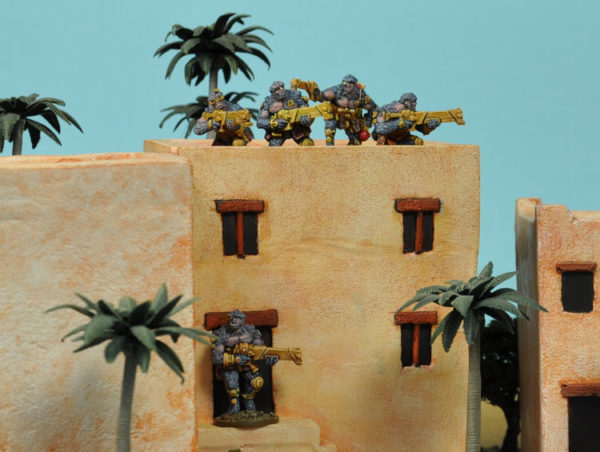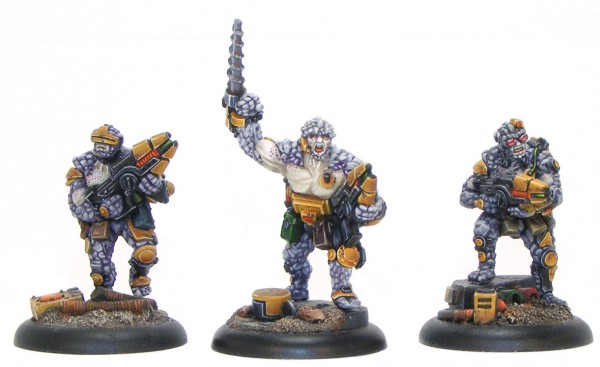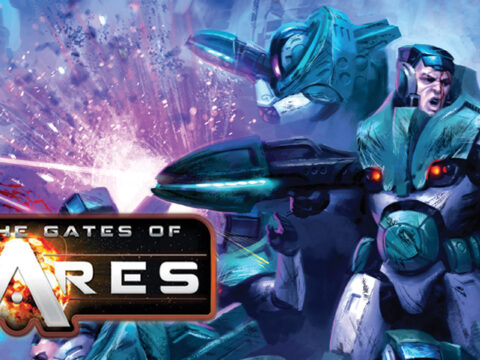(Note: This article is relates to the pre-release play test rules for Beyond the Gates of Antares and is now out of date. It has been replaced by an updated article – Reactions in Beyond the Gates of Antares).
Rick Priestley tells us more about Warlord’s forthcoming science-fiction project Beyond the Gates of Antares:
For this update on the Beyond the Gates of Antares game I’m going to talk a little bit about the game system. Don’t worry though, we do have plenty more models on their way – and we’ll be showing you some of those in next weeks newsletter. This time round I thought I’d just outline what I’ve been up to with the game system itself. It’s still a work-in-progress, especially in terms of detail, but by-and-large we’ve hammered out the core rules. Our aim is to publish a playable version online in a few months time, when everyone will get to have a go and volunteer their input via our forums.

Some of Rick’s Boromites take up position ready to react to any enemy advance.
The game is essentially a Sci-Fi development of Warlord’s existing Bolt Action game system, which means that players familiar with Bolt Action will have a good idea of the basic mechanics of play. We use the same Order dice – although there is wild talk of using a slightly modified version – but the Bolt Action dice does the job. The Order system is also broadly the same as for Bolt Action: each unit has a dice in the dice bag and the players pull one dice at a time to determine which side gets to take an action. The chief difference between Antares and Bolt Action is that the new game uses D10s for most resolution purposes rather than D6s or 2D6. This allows for a greater band of stats and modifiers, which is necessary to accommodate the different capabilities, size, robustness, and strength of the combatants. So, with the Order dice, the system is basically the same as Bolt Action, except that instead of rolling 2D6 against the unit’s modified morale value to act, you roll a single D10 against the unit’s Command stat. The new Command stat is used for giving orders. The orders themselves follow the same format as in Bold Action, except for ‘Ambush’ which works somewhat differently as we shall see.
Reactions
The reason why the Ambush order is different to Bolt Action is that it works with the new Reaction system. In Bolt Action units can sometimes react to enemy actions, for example a unit that has been charged by an enemy can shoot as it approaches, and units that are shot at can react by going Down. However, in Bolt Action all these reactions are somewhat ad hoc parts of the games system, utilising different mechanics and functioning in different ways. In Antares all of these reactions are subsumed within the same new mechanic. This allows for different types of reaction, and it makes room for us to add more should we wish. It also permits us to incorporate specific reactions into scenarios if that should prove useful (it does – more of that sort of thing in the future!). So, overall Reactions are a very flexible and useful feature of the game. To make a reaction a unit must take and pass a Reaction test. This test is taken against a new stat Initiative. So, where in Bolt Action we have a single morale stat, in Antares we have two different stats: Command for taking orders, and Initiative for making reactions. The Initiative test is otherwise taken in the same way as an Order test, in this case using a D10 against the unit’s modified Initiative stat. Pins on a unit work in the same way as in Bolt Action, and affect both Command and Initiative. The chief difference is that if a unit fails a Command roll it automatically goes Down (as a unit does in Bolt Action when failing an Order) however, if a unit fails a Reaction roll it instead gains +1 Pin marker.
So when can you use a Reaction?
Well, units can only attempt a Reaction if they either have no Order dice (i.e. if they have yet to receive an Order that turn) or if they have an Ambush order dice. The Ambush order acts as a kind of marker that the unit is alert and ready to react. Units that make successful reactions are allocated an Order dice corresponding to whatever they do (usually Fire or Run). Units can attempt reactions in the following circumstance.
Stand and Shoot. A unit that has been successfully assaulted by an enemy can react by shooting as the enemy approach. If successful, this gives the unit a Fire order and enables it to try and shoot down the approaching enemy before they can bring their known weapons to bear. This Stand and Shoot reaction replaces the equivalent reaction in Bolt Action – see what I mean about integrating the reactions in Bolt Action into the new system.
Firefight. A unit that is shot at by an enemy unit with a Fire order at ranges up to 20″ can react by shooting back. If successful the unit gets a Fire order and both units exchange fire. This shooting takes place simultaneously, so both units shoot at full effect before both remove casualties.
Run to Cover. A unit that has been shot at by an enemy unit with a Fire order at ranges greater than 20″ can react by running to cover, either to place itself out of the line of sight of the shooters, behind cover, or at longer range. The unit gets a Run order and moves before the enemy can shoot.
Escape! A unit that has been assaulted by an enemy can react by making an immediate run move to try and place itself out of reach of the assault. The unit gets a Run order and makes its move before the enemy unit can make its assault.
Go Down! A unit that is targeted by enemy shooting can react by going down. This is the only reaction that doesn’t need a Reaction test – a unit that Goes Down does so automatically and a Down order is placed next to the unit. However, there is an important difference between down units in Bolt Action and Antares. In Antares units with a Down order can’t automatically place the dice back in the dice bag at the end of the turn. Instead, they have to pass an Initiative test to do so. This makes it risky to Go Down as there’s a good chance you’ll stay down! On the plus side though, down units are much harder to hit in Antares than in Bolt Action – so it’s a trade off between mobility and safety.
Ambush. The Ambush reaction is also a little different to the general run of Reactions because only a unit that already has an Ambush order can make an Ambush. A unit can make an ambush if an enemy unit moves within its field of fire using either a run or advance order, presenting a clear shot as it does so. A Reaction test is needed as usual, and if successful the unit can fire with a Fire order and then revert to an Ambush order immediately afterwards if the player wishes. If the test is failed the unit can still make its Ambush by firing at the enemy, but retains the Fire order afterwards. This mean a successful Ambusher can make a further Ambush or other reaction subsequently in the turn, but a failed dice roll means you just get the one Ambush and that’s your lot. This is rather different than the way the Ambush works in Bolt Action, although in both games units that are give an Ambush order can make an Ambush – only in Antares the unit can potentially keep its Ambush order and continue to react throughout the turn.
One interesting feature of these reactions is that some troops, and some kinds of Panhuman mutants, have better or poorer Initiative compared to their Command values. So, some forces are good at getting orders off but worse at reacting, whilst others may be less adept when it comes to orders but very good at reacting. Because the different tests use different stats there is also room for character-based modifiers with professional leaders boosting Command and inspiring, heroic individuals boosting Initiative. It certainly makes for an interesting dynamic and means that Antares plays and feels very differently to Bolt Action in many ways, whilst retaining the core Order dice mechanic that makes Bolt Action such a fast-paced and exciting game.

Boromite Overseer team, consisting of Boromite Overseer with plasma carbine, tractor maul and reflex armour plus two Gangers with plasma carbines and reflex armour.

